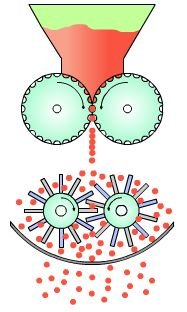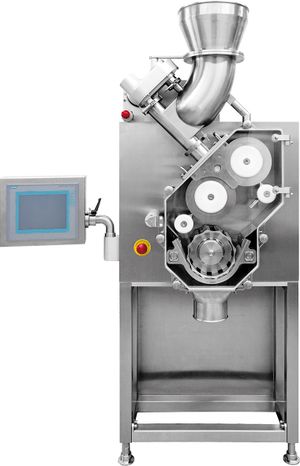Difference between revisions of "Dry Granulators"
(Created page with "Category:Particle Formation{{Knoppen}} <noinclude><!------------------------------------------------ * READ THIS FIRST * Only edit this page if you can improve the content. ...") |
|||
| Line 1: | Line 1: | ||
[[Category:Particle Formation]]{{Knoppen}} | [[Category:Particle Formation]]{{Knoppen}} | ||
[[File:Dry_Granulators_01.jpg|thumb|right|Outline of a typical dry granulator]] | |||
[[File:Dry_Granulators_02.jpg|thumb|right|Inside view of a dry granulator]] | |||
'''Dry granulators''' are used for dry granulation process. The dry granulation process is used to form granules without using a liquid solution because the product to be granulated may be sensitive to moisture and heat. Forming granules without moisture requires compacting and densifying the powders. In this process the primary powder particles are aggregated under high pressure. Sweying granulator or high shear mixer-granulator can be used for the dry granulation. | |||
Dry granulation can be conducted under two processes; either a large tablet (slug) is produced in a heavy duty tabletting press or the powder is squeezed between two rollers to produce a sheet of materials (roller compactor, commonly referred to as a chilsonator). | |||
When a tablet press is used for dry granulation, the powders may not possess enough natural flow to feed the product uniformly into the die cavity, resulting in varying degrees of densification. The roller compactor (granulator-compactor) uses an auger-feed system that will consistently deliver powder uniformly between two pressure rollers. The powders are compacted into a ribbon or small pellets between these rollers and milled through a low-shear mill. When the product is compacted properly, then it can be passed through a mill and final blend before tablet compression. | |||
==Video== | |||
<youtube>WAfH65Oxwck</youtube> | |||
==Source== | |||
[http://en.wikipedia.org/wiki/Granulation_%28process%29#Dry_granulation Wikipedia Dry Granulator] | |||
Latest revision as of 13:04, 3 October 2013
Dry granulators are used for dry granulation process. The dry granulation process is used to form granules without using a liquid solution because the product to be granulated may be sensitive to moisture and heat. Forming granules without moisture requires compacting and densifying the powders. In this process the primary powder particles are aggregated under high pressure. Sweying granulator or high shear mixer-granulator can be used for the dry granulation.
Dry granulation can be conducted under two processes; either a large tablet (slug) is produced in a heavy duty tabletting press or the powder is squeezed between two rollers to produce a sheet of materials (roller compactor, commonly referred to as a chilsonator).
When a tablet press is used for dry granulation, the powders may not possess enough natural flow to feed the product uniformly into the die cavity, resulting in varying degrees of densification. The roller compactor (granulator-compactor) uses an auger-feed system that will consistently deliver powder uniformly between two pressure rollers. The powders are compacted into a ribbon or small pellets between these rollers and milled through a low-shear mill. When the product is compacted properly, then it can be passed through a mill and final blend before tablet compression.
Video

